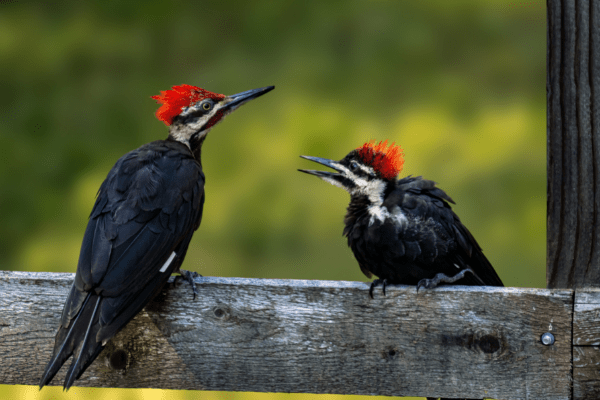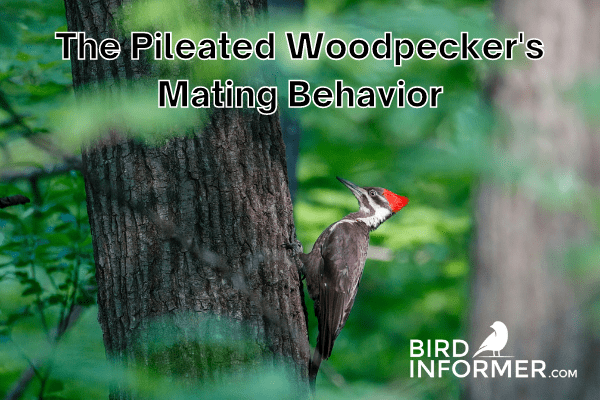Contents
Pileated woodpeckers are some of the most beautiful birds in North America. If you plan on attracting them to your yard, you must first know about the pileated woodpecker mating behavior.
The good news is that pileated woodpeckers don’t engage in completely unique mating behaviors.
Pileated woodpeckers have been long observed to engage in a “courting dance” to attract their mates. Once a woodpecker finds a mate, it will usually stay with them for the duration of their lives.
Of course, there is more information to cover when it comes to pileated woodpecker’s mating behaviors. In this guide, we’ll explain everything you need to know about this bird’s mating habits.
How Do Pileated Woodpeckers Mate?
The pileated woodpecker mating behavior process is actually quite simple. Once the birds have found each other, they will start to tap their bills together as a way of communicating with each other.
This “bill clacking” can last anywhere from a few minutes to an hour or more!
After this, the male and female will begin the courting dance. This involves lots of hopping around and pecking at the ground near each other.
If all goes well, the pair will eventually fly off together to find a nest site.
Curious to Learn More About Woodpeckers?
If you want to learn more about the bird that creates all the drumming and drilling noises in your backyard, click the button below…
What Happens After They Mate?
What happens after the birds mate is quite important as well. If you plan on attracting pileated woodpeckers to your yard, it’s worth knowing how they’ll behave once they’ve found a mate and breed successfully with them.
Once two pileated woodpeckers have mated together for life, the male will do most of the incubating during this process.
The female will lay up to six eggs at a time and leave her partner alone in their nest while she flies off looking for food.
While she does that, he must work hard to keep his young from falling out of their tree cavity home.
Once those baby birds hatch, both parents will take turns feeding them they are old enough to fly.
This is where most of the nesting behavior happens.
How Many Eggs Do Pileated Woodpeckers Lay?
Pileated woodpeckers lay between two and six eggs at a time, depending on how many they need to successfully raise their young in one breeding season.
Once these birds have mated together, though, they will usually stay with that partner for life unless something tragic occurs.
When Do Pileated Woodpeckers Mate?
Pileated woodpeckers usually mate during the fall and winter months
. This is when they are most active and look for potential mates.
These birds breed between January to May, but there might be some variance depending on where you live in North America.
Once the breeding season opens up again, these birds will go back to their normal behaviors of mating with other pileated woodpeckers or looking for a new partner who has lost theirs recently.
Related article: Best Woodpecker Bird Feeders
FAQ for Pileated woodpecker mating
To help you learn more about the mating behavior of the pileated woodpecker, we’ve added some frequently asked questions below.
How Do Pileated Woodpeckers Begin Nesting?
Pileated woodpeckers begin nesting in late April or early May, right after the breeding season is over.
These birds will lay two to six eggs at a time and usually incubate them for about three weeks before they hatch.
Once those young ones hatch, both parents take care of feeding them until they are old enough to fly on their own. This can be anywhere from 28 days up to 50 days depending on the location and food availability around where you live.
How Long Do Babies Stay With Their Parents?
Babies will stay with their parents anywhere from 24 – 28 days, depending on how old they are when they leave the nest.
Some babies might even stay with their parents until the next breeding season comes around.
This all depends on how well the young birds do in their first few months of life. If they have a good food supply and no major predators around, chances are they’ll stick around for a while.
If you want to attract pileated woodpeckers to your yard, it’s important that you provide them with a safe place to nest and raise their young.

Do Pileated Woodpeckers Compete for Mates?
Pileated woodpeckers don’t typically compete for mates.
They will look at their local area and choose the best, most appropriate partner they can find in that region.
If you want to attract pileated woodpeckers to your yard with food or nesting sites, it’s important not to place these things too close together.
If there are two piles of birdseed near each other but no nest site nearby, chances are this competition might lead them away from your yard altogether.
This is why providing a good home for these birds is so crucial. By doing enough research on how pileated woodpeckers behave when mating and rearing young, you’ll be able to set up an environment where these birds feel safe.
What Does a Pileated Woodpecker’s Courting Dance Look Like?
Pileated woodpeckers have a very interesting courting dance.
This involves one bird stepping, scraping, and bowing in a circle around its possible mate.
These birds will usually do this for at least a few minutes before they actually mate.
This is an important part of their mating behavior because it allows them to get to know each other in the wild without worrying about predators or anything else getting in the way.
What is Mating Like For Pileated Woodpeckers?
When pileated woodpeckers are ready to begin breeding, they’ll fly up into trees together and make loud calls back and forth between one another.
These sounds can be heard from at least 100 feet away.
Once these two birds have mated with one another, you might see them perform nesting behaviors like building nests inside tree trunks or chiseling out holes that fit them perfectly.
Other FAQs About The Pileated Woodpecker
What are Common Predators of the Pileated Woodpecker?
Pileated woodpeckers have a lot of predators when they are young.
These include hawks, owls, and even other pileated woodpeckers who would like to steal their nest site for themselves and keep the babies for food later on in life.
Other predators include:
- Squirrels
- Cats
- Snakes
This is why it’s important that you provide these birds with plenty of safe nesting sites where their young can grow up safely away from any potential predators.
How to Spot Pileated Woodpeckers?
Pileated woodpeckers are usually easy to spot because of their bright red crest on top of their head.
They also have a black and white body with a long, straight beak that they use to peck into trees in search of food.
You can usually find these birds near large forests or wooded areas where they can nest and raise their young safely.
Are Pileated Woodpeckers Rare?
Pileated woodpeckers are not rare birds.
In fact, they’re one of the most common woodpeckers in North America.
This doesn’t mean that you can’t attract them to your yard by providing food and nesting sites, though.
If you live near a large forest or wooded area, there’s a good chance you’ll see these birds at some point or another.
Ready to Spot More Pileated Woodpeckers?
As you can see, pileated woodpeckers don’t have unusual mating habits. Aside from their courting dance, pileated woodpeckers mate in ways very similar to their sister birds.
Knowing how these birds mate is essential if you want to spot them. It’s also great for knowing when these birds will show up since pileated woodpeckers have rather secretive nesting habits.

